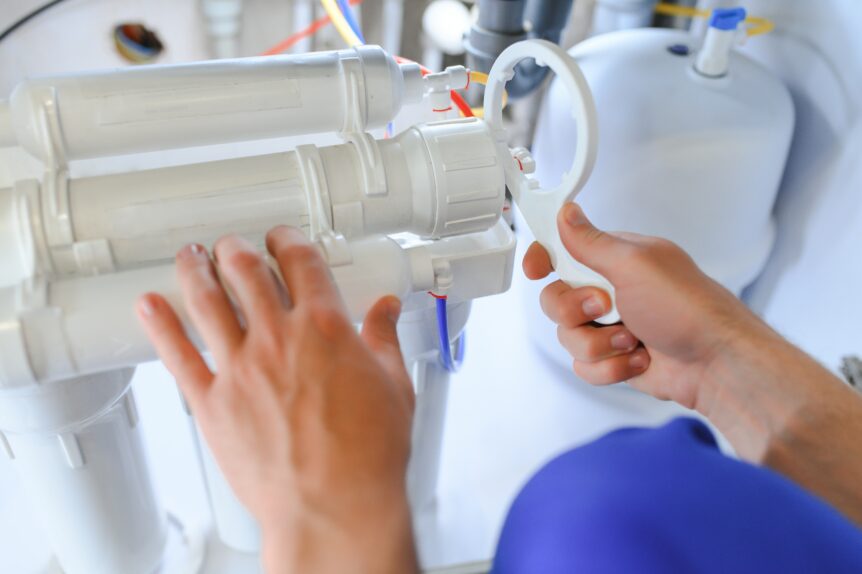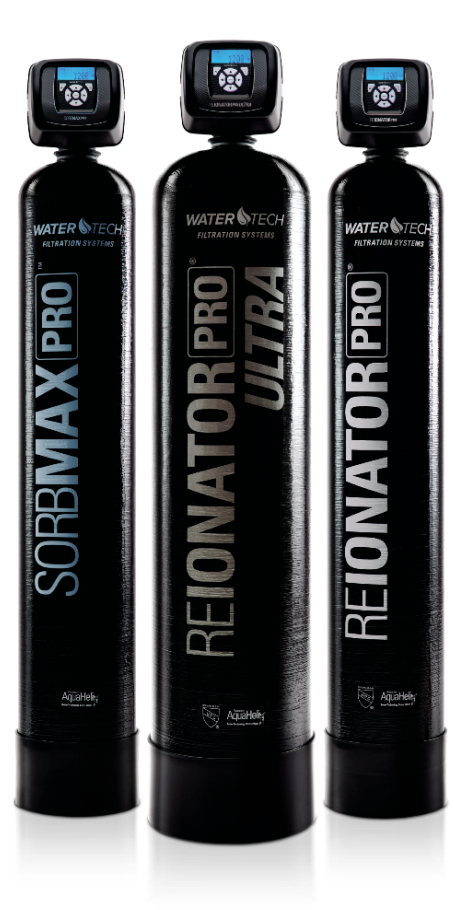| Key Takeaway:
Hard water is common in many areas, and reducing measured hardness at the source is the most reliable way to limit new scale. Salt-based ion-exchange softeners address calcium and magnesium directly; whole-home carbon filtration can be paired to improve taste and odor from chlorine or chloramine. A brief water test provides the numbers (gpg) needed to size a system that fits your home. |
Hard water shows up in everyday ways—spots on glassware, buildup on fixtures, and soap that doesn’t quite lather. Over time, deposits can collect inside water-using equipment, which may affect performance and maintenance. Addressing minerals at the source simplifies cleaning, helps appliances run as designed, and makes day-to-day water feel better on skin and hair.
This guide covers what hard water is, how softening works, and where whole-home filtration fits. The straightforward path is to measure hardness, right-size a softener to that result and household use, then add carbon filtration if taste or odor is present.
What hard water looks like at home
Hardness is primarily calcium and magnesium that water picks up as it moves through soil and rock. It’s measured in grains per gallon (gpg), and even modest levels can change how soaps behave and how easily mineral film forms on surfaces. That’s why dishware may spot, shower doors cloud up, and laundry feels a bit stiff.
Less visible are the effects inside pipes and appliances. Scale can layer onto heating elements and heat-exchange surfaces, forcing equipment to work harder to deliver the same result. Over years, that can mean more maintenance, reduced efficiency, or shorter service life for heaters, dishwashers, and washing machines. Because utilities differ in source water and disinfectants, numbers can vary by neighborhood and season—one more reason to start with a simple water test.
How a softener actually fixes hardness
Ion exchange is the standard residential method for reducing hardness. Water passes through resin that swaps sodium or potassium for calcium and magnesium. The result is a measurable drop in gpg and a practical reduction in new scale formation throughout the home.
Salt-free conditioners don’t remove hardness minerals; they change how minerals behave so scale is less likely to adhere. That can help keep surfaces cleaner, but it won’t lower your hardness number. If your goals include better soap performance, fewer spots, and protection for equipment, choose ion-exchange softening first. Where taste or odor is also a concern, pair softening with whole-home carbon filtration.
Quick facts you can use
|
Systems that fit most homes
Most households begin with a softener sized to tested hardness and everyday water use. Resin volume and regeneration frequency set the cadence for steady operation without over- or under-cycling; those inputs come directly from the water test and typical daily gallons. Feature sets vary across Pro Series configurations so you can match capacity and controls to the home.
Where municipal taste or odor is noticeable, pair softening with whole-home carbon so showers, laundry, and cooking all benefit. Media type and contact time influence performance, which is why many families add Infinity Series filtration alongside softening. If interest is limited to drinking water at a single tap, an under-sink reverse osmosis system adds a focused final polish.
Planning the install (without headaches)
Whole-home softeners are installed at the point of entry so all fixtures receive treated water. Planning for plumbing layout, drain routing, a bypass valve, and programming helps ensure consistent performance. If the property has irrigation, leaving it on bypass can conserve softening capacity.
Some owners install equipment themselves; others prefer a professional. A quick check on space, electrical, and drain needs before the unit arrives saves time on install day. Model-specific steps and care schedules are outlined in support. If you want a plain-spoken recommendation based on current test results and usage, a local specialist can size the system and set expectations.
Everyday benefits of softer water
Protection for plumbing and water-using equipment. Lower hardness means fewer new deposits on heat-transfer surfaces and internal passages, supporting steady operation over time.
Smoother routines. With fewer minerals in the mix, soaps lather and rinse more predictably, so cleaning and personal care typically take less product and effort. You’ll also see less film on tile, glass, and fixtures, which makes regular cleanup simpler.
Inquiry and assessment
Testing is the quickest way to move from guesswork to a clear plan. Results show hardness in gpg and indicate whether chlorine or chloramine are present—details that directly inform softener capacity and any companion filtration.
If you want a skim-level refresher before testing, key definitions help with terms like gpg and regeneration. Numbers specific to your home come from a short water test, and a concise sizing note can come from a local specialist.
Water softener FAQs
What are the signs of hard water?
Are salt-free conditioners the same as softeners?
How much maintenance is typical?
Where does drinking-water filtration fit?
Map out your setup
A practical sequence for most homes is to measure hardness, select a softener sized to that result and daily use, and add carbon filtration if chlorine or chloramine are present. That approach addresses the mineral load that drives scale while improving taste and odor across the home.
Current numbers for your address come from a short water test, and a plain-spoken recommendation can come from a local specialist.


